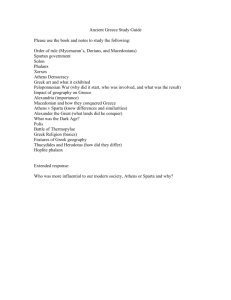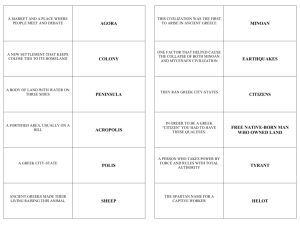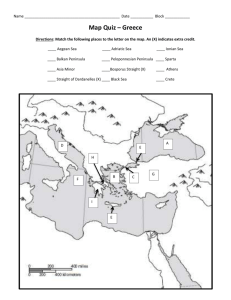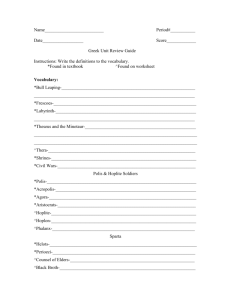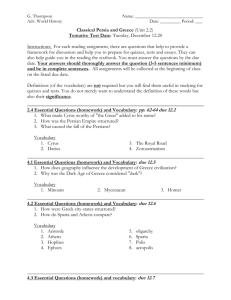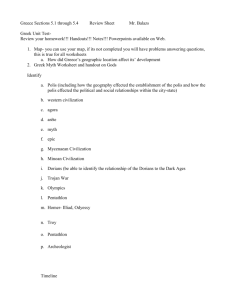ANCIENT AND CLASSICAL GREECE
advertisement
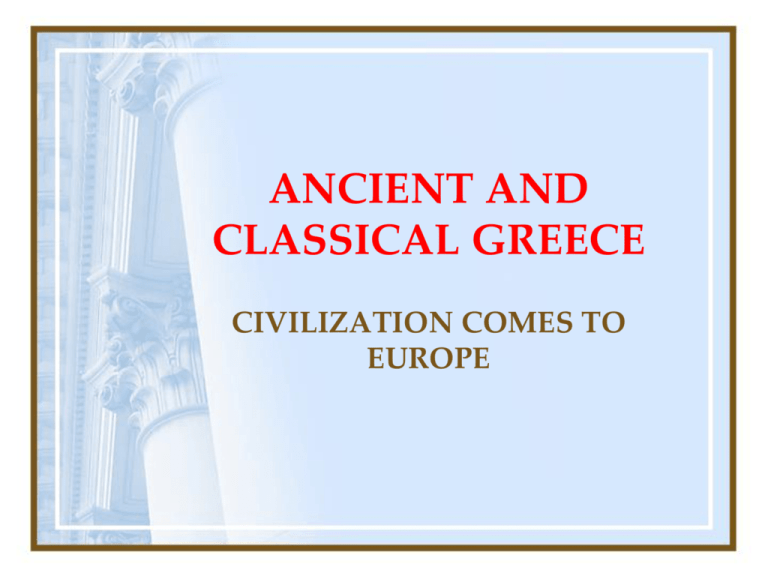
ANCIENT AND CLASSICAL GREECE CIVILIZATION COMES TO EUROPE PHYSICAL GEOGRAPHY The Land – – – – – Mountains dominate land; cross land travel difficult Fertile river valleys were center of settlement River valleys formed basis of polis No place more than a few miles from sea Outdoor life common due to temperate climate The Sea ₋ ₋ ₋ Greece is a series of peninsulas, islands Sea travel easier than land communication Most Greeks took to the sea Economy ₋ ₋ ₋ Agriculture: Grains, honey, olives, grapes Herding: Goats, sheep, cattle Trade: Necessary to make up for lack of resources PHYSICAL MAP OF AREA MINOAN SOCIETY Island of Crete ₋ From 2200 to 1450 B.C.E., center of Mediterranean commerce ₋ Received early influences from Phoenicia and Egypt ₋ Established colonies on Cyprus and islands in the Aegean Sea Knossos ₋ ₋ ₋ ₋ Minoan society arose on Crete Arose late 3rd millennium B.C.E. Palaces at Knossos between 2000, 1700 B.C.E. Linear A, a kind of written language, is found Society – Evidence of egalitarian society; women had rights – Agriculture was important: grapes, olives, fishing, wheat – Trade was very important: marble, artifacts, cloth Decline of Minoan Society ₋ After 1700 B.C.E., earthquakes, volcanic eruptions, tsunamis ₋ After 1450 B.C.E., wealth attracted a number of invaders ₋ By 1100 B.C.E., Crete fell under foreign (Hellenic) domination THE ISLAND OF CRETE MYCENAEAN GREECE Mycenaean society – – – – – – Indo-Europeans settled in area, 2000 B.C.E. Settled in Peloponnesus around Mycenae Adapted Minoan Linear A into Linear B Fortified agricultural settlements Society resembled Aryan: emphasis on war, trade Kingdoms ruled by strongest of nobles; constant strife Chaos in the eastern Mediterranean 1100 to 800 BCE ₋ Mycenaeans engaged in Trojan war, about 1200 B.C.E. ₋ ₋ ₋ ₋ ₋ Troy may have been a Hittite city-state and trade rival Tomb of Agamemnon, Troy excavated by von Schliemann in late 1700s Recorded by Homer in the Illiad and the Odyssey More invasions by Hellenic tribes “Sea Peoples” ₋ ₋ Later Hellenic invaders moved by sea along coasts Seemed to have raided into Palestine, Egypt as Philistines ANCIENT GREECE THE GREEK DARK AGES 800 TO 500 BCE – Called Dark Ages due to loss of writing – Age remembered through oral traditions • Likely the Age of Homer • Oral traditions of Illiad and the Odyssey – A period of migration and warfare – Hellenes spread to Italy, Sicily, Asia Minor, Cyprus The Hellenes ₋ ₋ ₋ ₋ Indo-Europeans who settled in area Tribes include Dorians, Attics, Achaeans Originally aristocratic societies Warfare, slavery, and trade common GREEK TRIBES THE POLIS • Greek City-State – – – – – Polis = city-state; Poleis = city-states Metropolis = city of polis Acropolis = fortified center of city Boundaries shaped by geography Terms of politics come from POLIS • Politics, politic, politician, polite, polity • Police, metropolis, metroplex • Most important ◊ Athens ◊ Sparta MAP OF GREEK POLEIS POLITICAL FORMS • Archon: Greek for “ruler” – English “archy” • Kratien: Greek for “to rule” – English “cracy” – – – – – – – – – – – – – Demos: People – Democracy (direct election) Aristos: The Best – Aristocracy (nobles) Oligos: The Few – Oligarchy (rule by select few) Monos: One – Monarchy (rule by a king) Di: Two – Diarchy (Sparta’s state had 2 kings) An: None – Anarchy (No government) Theos: God – Theocracy (Rule by priests, religion) Geron: Old Man – Gerontocracy (rule by elderly) Pater: Father – Patriarchy (rule by males) Mater: Mother – Matriarchy (rule by women) Auto: Self – Autocracy (dictatorial rule) Tyrannos: Tyrant – Tyranny (rule by an usurper with supreme power) Ethnos: Ethnic or locals – Ethnarchy (rule by the local people) The Development of Democracy in Ancient Greece Monarchy Definition Visual Form of government in which ruling power is in the hands of one person Oligarchy Form of government in which ruling power is in the hands of a few leaders Tyranny Form of government in which ruling power is in the hands of a person who has seized control Democracy Form of government in which ruling power is in the hands of the people The Development of Democracy Monarchy Oligarchy Tyranny How was this form of government practiced in ancient Greece? Mycenaeans paid taxes to king, obeyed laws, depended upon them for protection Political decisions were made by aristocrats and selected members of the middle class. Ordinary citizens had little say in how the city-state was run. With support from the middle class, tyrants seized power to reform laws, aid the poor, and cancel debts. Why did this form of government decline in ancient Greece? Mycenaean kings lost power when fighting rival monarchs over land and raw material. Dorians also destroyed the Mycenaean kingdoms. Some oligarchs ruled harshly and their subject rebelled. Others lost the faith of their supporters because they could not solve key problems such as food shortages. Some tyrants became harsh and greedy and were overthrown. Democracy Athens was the birthplace of democracy. All male citizens could participate in Athenian government. The Assembly made laws and it was enforce by the Council of 500. SPARTA Sparta – – – – – Situated in a fertile region of the Peloponnesus Began to extend control during the 8th and 7th centuries B.C.E. Reduced neighboring peoples to the status of helots, or servants By 6th century B.C.E., helots outnumbered Spartans by 10 to 1 Maintained domination by a powerful military machine Spartan society Discouraged social distinction, observed austere lifestyle Distinction was drawn by prowess, discipline, and military talent Commitment to military values was strong Society was a military aristocracy; state ruled by two kings Young boys, girls educated in military barracks After marriage, men still lived at barracks; women ran homes Women: surprisingly free in comparison to other Greek women All merchants were foreigners licensed by the state LACONIA’s administrative capital was Sparta LACONIA: SPARTA • Athens – – – – ATHENS Population growth, economic development caused political strain Sought to negotiate order by democratic principles Citizenship was open to free adult males Foreigners, slaves, and women had no rights • Athenian society – Maritime trade brought about prosperity – Aristocratic landowners were principal beneficiaries _ Society valued education, philosophy and beauty. • Class Conflict – Owners of small plots began to sell lands – Many debtors sold themselves into slavery – Class conflict intensified, 6th century B.C.E. • Solon and Athenian democracy – Solon forged a compromise between the classes – Opened polis councils for any male citizen • Pericles (ca. 443-429 B.C.E.) – The most popular democratic leader of Athens – Ruled Athens during its Golden Age ATHENIAN THASSALOCRACY GREECE & THE LARGER WORLD Greeks founded more than 400 colonies – Controlled Black, Aegean, Adriatic, Ionian Seas – Settled Sicily, S. Italy, Corsica, France, Spain, Africa – Settled Coasts of Yugoslavia, Albania, Turkey, Cyprus Effects of Greek colonization ₋ ₋ ₋ ₋ ₋ ₋ ₋ Facilitated trade among Mediterranean lands Facilitate exchanges between peoples, cultures Spread of Greek language and cultural traditions Stimulated development of surrounding areas Spread civilization to ancient, Neolithic areas Warfare increased Technology stimulated: naval, navigation, astronomy THE GREEK WORLD GREEK MILITARY • Based on citizen soldiers – Lightly armed, armored foot soldiers (Hoplites) • • • • Carry shields, long spear All citizens had to furnish own arms, armor All citizens expected to fight in army, navy All citizens had military training in school – Fought in massed formations called Phalanx • Very useful in rugged terrain; used 10’ long pikes • Easily defeats massed cavalry favored by others • Greek navy – Rowed vessels called galleys • Most famous was the trireme or three oar banked • Rowed by free citizens • Fought by ramming other vessels; than hand to hand – Greek fleets included larger vessels • Equites or mounted troops were aristocrats THE PERSIAN WARS (300) • The Persian War (500-479 B.C.E.) – Cyrus and Darius controlled Anatolia – Greek cities on Ionian coast revolted, 500 B.C.E. – Darius’ Invasion • The battle of Marathon, 490 B.C.E. • Greeks led by Spartans and Athens battled Persia to a draw – Xerxes Invasion • • • • To fight Persians, Athenians build a wall of wood, or a navy Xerxes seized, burned Athens Athenian navy destroys Persian in the battle of Salamis, 480 B.C.E. Persian army retreated back to Anatolia, 479 B.C.E. • The Delian League – – – – Alliance among Greek poleis against Persian threat Military force from Athens, finance from other poleis As Persian threat subsided, poleis no longer wanted to participate Athens uses navy to turn Delian League into Athenian Empire MAPPING THE PERSIAN WARS PELOPONNESIAN WAR • Pericles Rebuilds Athens – Athens experiences a Golden Age – Pericles turns Delian states into Athenian colonies • 30 Year Civil War (431-404 B.C.E.) – Athens and Allies vs. Sparta and Allies – Costly victories/defeats and plague wreck city – Unconditional surrender of Athens, 404 B.C.E. • Hegemony first by Sparta and then by Thebes – Constant warfare between leagues, allies – Spartan hegemony replaced by Theban – Greece horribly weakened – Athens remained intellectual center of Greece THE PELOPONNESIAN WAR
